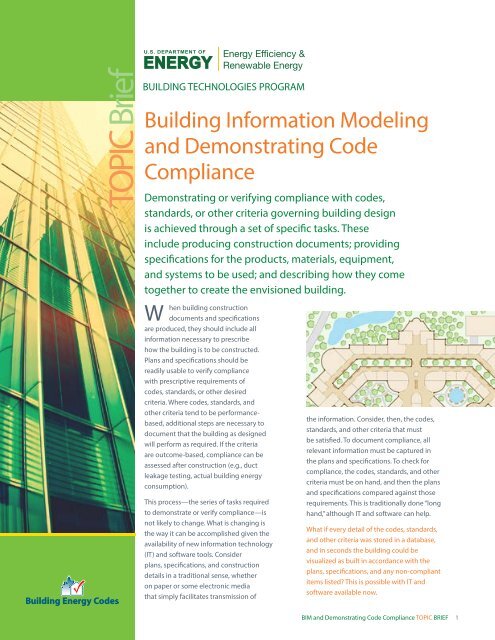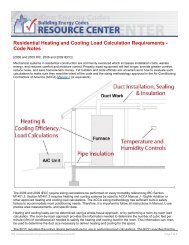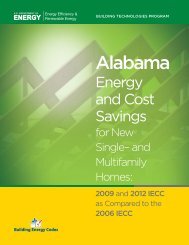BIM Topic Brief - Building Energy Codes
BIM Topic Brief - Building Energy Codes
BIM Topic Brief - Building Energy Codes
- No tags were found...
Create successful ePaper yourself
Turn your PDF publications into a flip-book with our unique Google optimized e-Paper software.
TOPIC <strong>Brief</strong>BUILDING TECHNOLOGIES PROGRAM<strong>Building</strong> Information Modelingand Demonstrating CodeComplianceDemonstrating or verifying compliance with codes,standards, or other criteria governing building designis achieved through a set of specific tasks. Theseinclude producing construction documents; providingspecifications for the products, materials, equipment,and systems to be used; and describing how they cometogether to create the envisioned building.Whenbuilding constructiondocuments and specificationsare produced, they should include allinformation necessary to prescribehow the building is to be constructed.Plans and specifications should bereadily usable to verify compliancewith prescriptive requirements ofcodes, standards, or other desiredcriteria. Where codes, standards, andother criteria tend to be performancebased,additional steps are necessary todocument that the building as designedwill perform as required. If the criteriaare outcome-based, compliance can beassessed after construction (e.g., ductleakage testing, actual building energyconsumption).This process—the series of tasks requiredto demonstrate or verify compliance—isnot likely to change. What is changing isthe way it can be accomplished given theavailability of new information technology(IT) and software tools. Considerplans, specifications, and constructiondetails in a traditional sense, whetheron paper or some electronic mediathat simply facilitates transmission ofthe information. Consider, then, the codes,standards, and other criteria that mustbe satisfied. To document compliance, allrelevant information must be captured inthe plans and specifications. To check forcompliance, the codes, standards, and othercriteria must be on hand, and then the plansand specifications compared against thoserequirements. This is traditionally done “longhand,” although IT and software can help.What if every detail of the codes, standards,and other criteria was stored in a database,and in seconds the building could bevisualized as built in accordance with theplans, specifications, and any non-compliantitems listed? This is possible with IT andsoftware available now.<strong>BIM</strong> and Demonstrating Code Compliance TOPIC BRIEF 1
TOPIC <strong>Brief</strong><strong>BIM</strong> and Demonstrating Code Compliance (Continued)<strong>Building</strong> information (BI) has been captured on paper fordecades and more recently in electronic versions. Theavailability of software makes it possible to load BI intoa program that then generates a BI model (<strong>BIM</strong>). Whohasn’t considered a kitchen remodel or some other homeimprovement program without being able to visualize itthrough software? While very little data are necessaryto visualize a kitchen remodel (e.g., color, texture, style,dimensions), that BI file of kitchen design inputs representsa <strong>BIM</strong>. Now expand this concept to an entire building. Allthe information relevant to documenting or verifying codecompliance can be placed in the <strong>BIM</strong>. With respect to energycodes, <strong>BIM</strong> inputs can include:• Dimensions• Material properties• Locations of systems• How the envelope is assembled• What is conditioned or non-conditioned• Lighting wattage• Space names• Any other item related to energy codes, standards andother criteria to be satisfied.Once incorporated in the <strong>BIM</strong>, the data are in an electronicformat that allows them to be easily “read” and applied tocreate 2-D, 3-D, and 4-D (time) views of the entire buildingor any portion of the building. The <strong>BIM</strong> is then availablefor “use” by other software to perform certain tasks. Forexample, energy modeling and analysis tools can work withinthe <strong>BIM</strong> environment using available BI to generate designspecific results. Using a highly detailed and accurate <strong>BIM</strong> ofa facility also allows designed performance to be validatedupon commissioning and then monitored over the life cycleof the facility to ensure it performs the way it was designedthroughout its life. In addition, feedback to the <strong>BIM</strong>-basedenergy analysis tools allows constant improvement to ensurepredictive performance is in fact a true measure of the actualperformance.The type, quantity, and quality of data in the <strong>BIM</strong> determineits ability to perform specific tasks. Cost estimating andscheduling are some simple examples. Another is clashdetection, when software can identify instances where morethan one object (e.g., wire, duct, structural column, pipe,doorway) is designed to share the same space. It is certainlymuch easier, less costly, and less time consuming to identifythese instances before construction. Consider complianceverification as a form of clash detection. <strong>Codes</strong>, standards,and other criteria can be formatted in a way that softwarecan recognize and apply as a rule set in clash detection. The<strong>BIM</strong> then represents the building, against which the codes andstandards rule set is compared. Where the <strong>BIM</strong> “clashes” withthe rule set, an item of non-compliance is identified. Clashescan then be dealt with prior to construction, which results infewer non-compliant issues seen by the code official in thefield.Work on code compliance checking and verification wasconducted by the International Code Council (ICC) from 2005to 2009 as the SMART<strong>Codes</strong> project. Rule sets for the energycode and accessibility and egress provisions of the buildingcode were developed and documented. Although work on theSMART<strong>Codes</strong> project at ICC has not continued, others suchas Fiatech and <strong>BIM</strong> software developers continue to exploreautomated code checking through <strong>BIM</strong>. It is envisioned thatas this application for BI modeling—along with others such ascost estimating, scheduling, and even virtual construction—advances, it will increase in use and yield reductions incosts and timeframes associated with building design andconstruction.The work of organizations supporting the development ofopen <strong>BIM</strong> standards through the buildingSMART alliance willensure that all users of BI, including code officials, can accessand use such information to perform their duties.Further resources on <strong>BIM</strong> include:• The <strong>Building</strong>SMART Alliancewww.buildingsmartalliance.org• The Business Value of <strong>BIM</strong>: Getting to the Bottom Line,McGraw Hill Construction www.bim.construction.com/research/• www.fiatech.orgBUILDING TECHNOLOGIES PROGRAMEERE Information Center1-877-EERE-INFO (1-877-337-3463)www.eere.energy.gov/informationcenterAugust 2012PNNL-89858For information on <strong>Building</strong> <strong>Energy</strong><strong>Codes</strong>, visit www.energycodes.gov2 <strong>BIM</strong> and Demonstrating Code Compliance TOPIC BRIEF
















